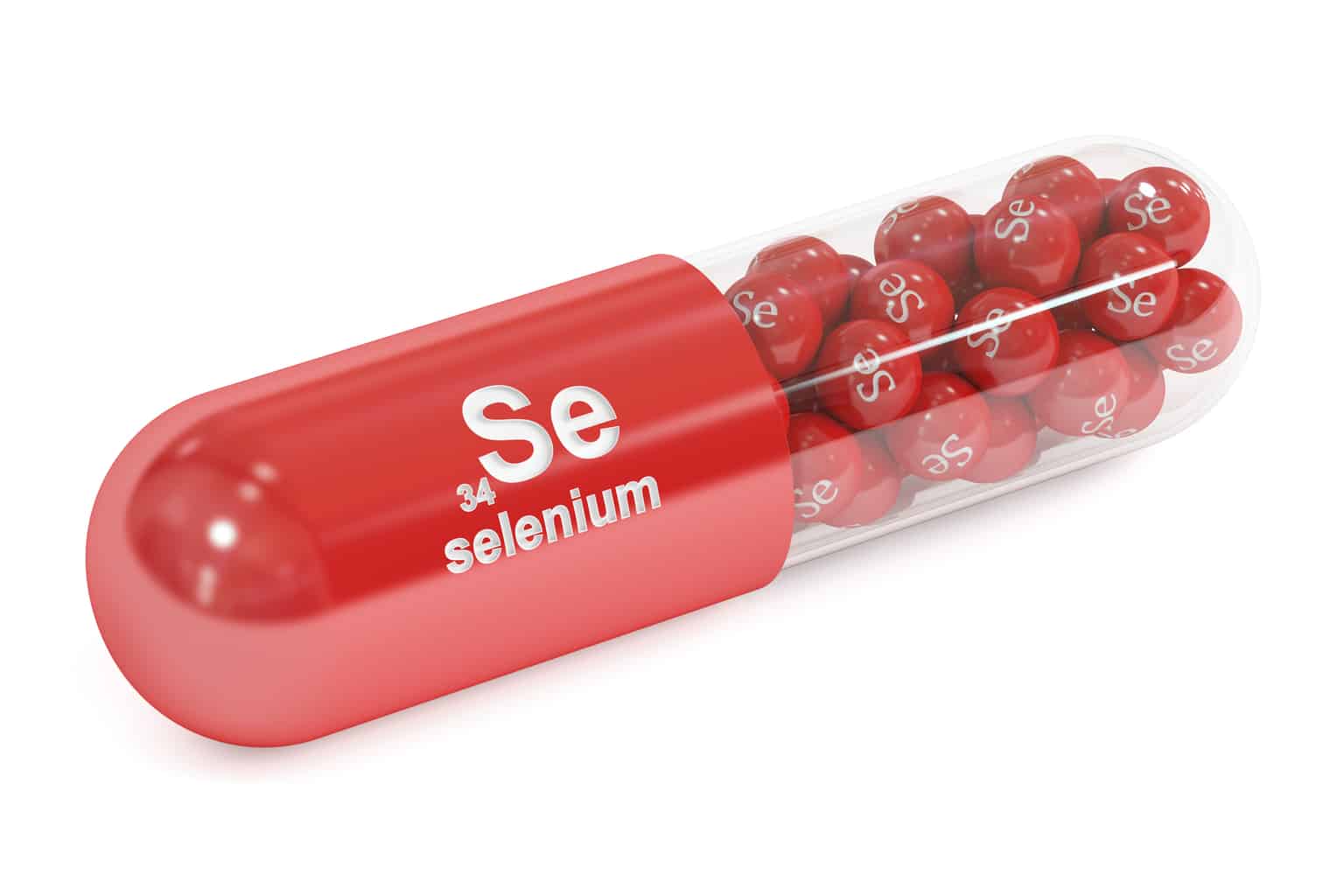
[cmamad id=”21326″ align=”center” tabid=”display-desktop” mobid=”display-desktop” stg=””]
New studies show that this all-natural organic compound boosts the immune system and keeps the prostate healthy well into old age…
—-Important Message—-
Double the Blood Supply to Your Penis Right Now – Here’s How
When your penis gets more oxygen-rich blood, your erections become harder, stronger, more engorged…
And they last longer, so you can have 30-minute or 60-minute sex every single day, maybe even twice a day…
I’ve just discovered how to double this oxygen-rich blood supply to the penis… and it works in just 7 minutes.
You can do it now.
So 7 minutes from now, you can start experiencing great erections again, even if you’ve been struggling for years…
————
This Natural Amino Acid Prevents Prostate Cancer
Though it’s not as well-known as tryptophan, cysteine, and leucine, selenomethionine is also an all-natural amino acid.
Selenomethionine is found at the highest concentrations in plants grown in selenium-rich soil, and also in animals that eat those plants.
Selenium in the body is primarily stored as this specific amino acid.
Although selenium in just about any form is beneficial (up to a point), selenomethionine is a bit more than “just another source of selenium.”
This one specific amino acid is effective in preventing cancers of all sorts and in many ways – especially those involving the prostate.
But before we talk about exactly how it accomplishes what it does, let’s first have a look at what it’s been shown to do:

In 1998, these researchers conducted a prospective study to determine prostate cancer incidence.
They recruited nearly 1,000 men who were, on average, sixty-two years of age and divided the recruits into two approximately equal groups:
They gave one group 497 micrograms of selenomethionine per day (or 200 micrograms of selenium), and the other group served as the control.
After four and a half years, there were 48 cases of prostate cancer.
And of these 48, only 13 were among the selenomethionine group.
This makes for a risk ratio of .37 in the group taking 497 micrograms of selenomethionine per day…
[cmamad id=”21327″ align=”center” tabid=”display-desktop” mobid=”display-desktop” stg=””]
So the selenomethionine group had a 63% reduced incidence of prostate cancer.
The authors seem to agree that 497 micrograms per day is a safe dose level.
“There were no dermatological signs of selenium (Se) toxicity during the trial.”
These results seem shocking, but they should really come as no surprise.
Selenomethionine had already been shown to inhibit the synthesis of polyamines.
Polyamines are growth factors normally synthesized within the cell via dietary methionine.
Polyamines bind and interact with DNA directly to promote replication.
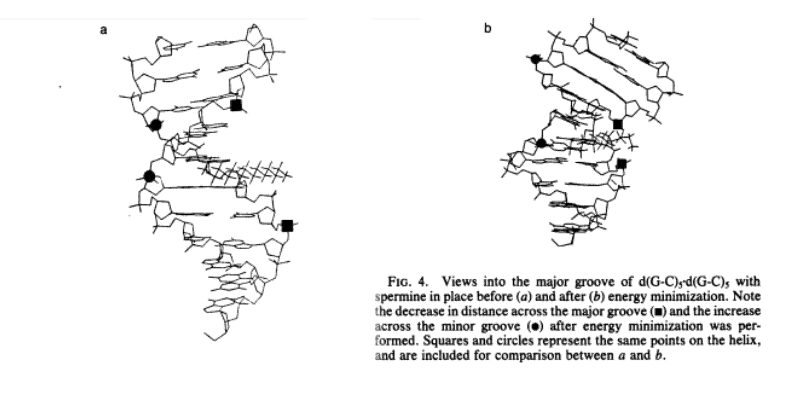
According to studies, just a small .69% increase in dietary methionine intake can increase the body weights of rats by 250% after two years.
In a later study, the same author used the same dietary methionine intakes and similar rats to demonstrate an 83% reduction in colon cancer.
Enzymes involved in polyamine synthesis are routinely found upregulated in prostate cancer.
They are also a prerequisite for experimentally-induced rat cancers, and inhibitors of these enzymes will reliably reduce the incidence of prostate cancer in rats.
So I think it’s fair to assume that polyamines are largely responsible for this.
And I think many people would agree.
Prostate cancer is the most common cancer in America – and more polyamines are synthesized there than in any other organ…
This probably isn’t a coincidence.
Increased polyamine synthesis occurs there because sperm cells need a high concentration – they use it to replicate DNA in the egg.
Methionine and selenomethionine are more or less equivalent in forming the structural basis of most proteins.
And they can freely substitute for each other…
But selenomethionine is quite different from methionine in one crucial aspect.
Selenomethionine can do everything methionine can – except form polyamines.
And because of its similarity to methionine, it can bind and inhibit the enzymes that normally produce them:

Selenium in various forms has been studied for decades.
But these scientists wanted to know explicitly whether selenomethionine could inhibit polyamine synthesis.
This was a simple experiment – essentially, they only needed polyamines, cancer cells, and HPLC (high-performance liquid chromatography).
After 24 hours at 65 micrometers of selenomethionine, they found a 52% reduction in spermine.
Spermine is the most powerful polyamine when it comes to increasing replication – and the one with the greatest DNA-binding ability.

Putrescine – the shortest and smallest “polyamine” – had been found increased in the (+)-selenomethionine cells because it’s a precursor for the longer, more active forms.
This can be seen as the “backed-up” substrate, indicative of the upstream enzyme inhibition.
But putrescine, as such, cannot induce DNA replication…
Although it’s commonly called a polyamine this is actually a misnomer, it is only a diamine (not yet a polymer).
So selenomethionine is similar in function to the research drug dimethyl ornithine, a slightly modified amino acid that binds and inhibits polyamine-producing enzymes.
But that’s not all: Selenomethionine has one more distinct function.
Selenomethionine can become selenocysteine through trans-selenation, which in turn can be used in seleno-enzymes such as iodothyronine deiodinase.
This is what makes selenium essential for activating thyroid hormone.
But other seleno-enzymes are also important.
Glutathione peroxidase in one such selenoenzyme.
This one is responsible, along with catalase, for detoxifying all intracellular hydrogen peroxide.
The activity of this enzyme depends on selenium intake, and this can lead to surprising downstream effects:
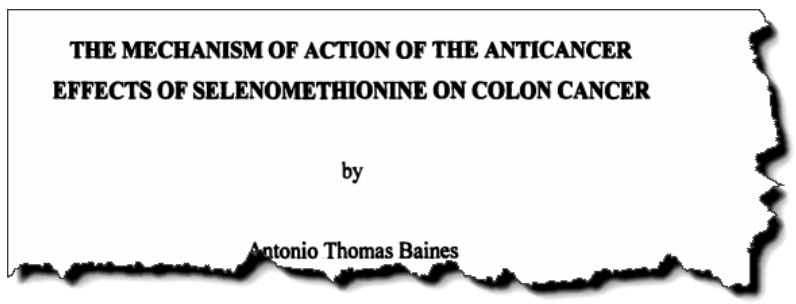
In a 150-page doctoral dissertation (double-spaced), soon-to-be doctor Antonio Baines discussed yet another effect of feeding selenomethionine to rats.
He found the expected reduction in growth with just 32 micrometers of selenomethionine, but also a reduction in prostaglandin E2.
He also saw decreased levels of cyclooxygenase (COX-2), the enzyme that makes prostaglandins – but that took six days:
“However, with COX-2, there was a dose-dependent decrease in protein expression at day 6.”
This is in no way consistent with polyamine inhibition, which occurs nearly immediately.
In addition, polyamines are responsible for transcribing more general metabolic “housekeeping genes” and not inducible enzymes like COX-2 and iNOS (nitric oxide).
But this is actually very easy to understand:
COX-2 is transcribed by nuclear factor kappa (NF-κB), a transcription factor activated by hydrogen peroxide.
Hydrogen peroxide is under the influence of catalase and glutathione peroxidase, a selenoenzyme that converts it into water and oxygen.
This is why selenium, in any form, always:
(1) Decreases hydrogen peroxide concentrations
(2) Reduces nuclear factor kappa activity
(3) Lowers cyclooxygenase-2 expression
(4) Helps eliminate growth-promoting prostaglandin E2
…in that order.
There have certainly been enough studies published to demonstrate this piecewise – one study at a time, every step of the way.
But this one study (below) proves the entire pathway:

In the first arm of the experiment, they made two batches of cells.
They grew one batch in a selenium-deficient solution and the other with 2 μM of sodium selenite added.
Previous studies showed that this would increase glutathione peroxidase activity, but they double-checked anyway:
“The selenium/glutathione peroxidase activity was determined to be significantly higher (10-fold) in selenite-supplemented cells than…in selenite-deficient cells.”
And that should translate to a lower resting hydrogen peroxide concentration.
Since nuclear factor kappa responds to hydrogen peroxide in particular, by forming a disulfide bond, you would expect all the genes it encodes to be reduced in proportion (i.e. iNOS, COX-2).
This was, in fact, the case…
They showed a delayed response of cyclooxygenase induction in selenium-sufficient cells:

Hydrogen peroxide is actually a “second messenger” through which cytokines such as tumor necrosis factor alpha, a signal for COX-2.
Hydrogen peroxide, no matter where it’s from, can induce the expression of genes through certain transcription factors.
This is as true with free iron or cytokines as when directly applied to the cell.
And, predictably, this decrease in cyclooxygenase with added selenium translated into lower prostaglandin E2:
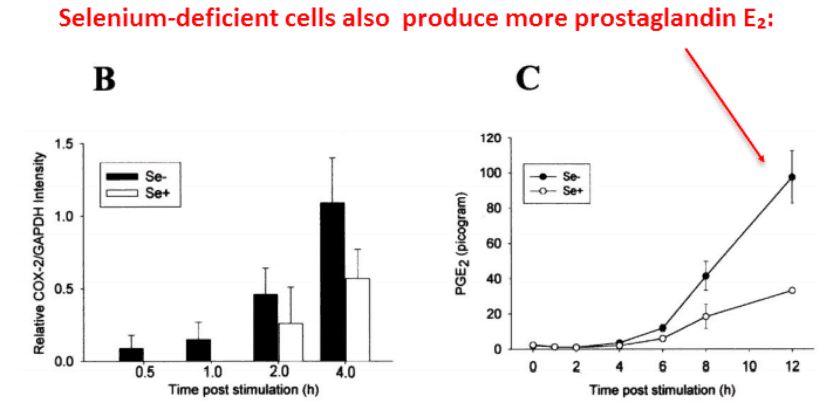
Prostaglandin E2 is a growth factor, a carcinogen, and often will increase cancer growth when applied directly.
And cyclooxygenase is commonly upregulated in cancer.
The authors also showed that nuclear factor kappa (NF-κB) is necessary for cyclooxygenase transcription.
They also observed NF-κB in the nucleus (where it shouldn’t be) to a much greater extent in the selenium-deficient cells:
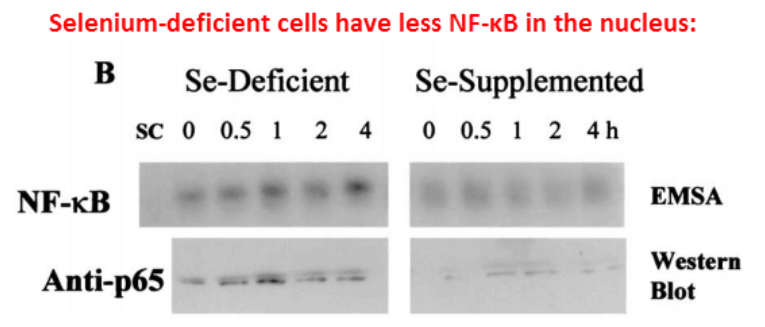
The only thing they didn’t prove was that it takes about six days, the time frame observed in the Baines study discussed above.
Other studies, however, did replicate the delay.
“Addition of 0.25 pg/ml (picograms per milliliter) selenium to selenium-deficient cells restored control phospholipid hydroperoxide-glutathione-peroxidase activity within 8 hours, whereas glutathione peroxidase activity needed 7 days.”
This is the time frame needed to gain maximum cell protection detoxification of hydrogen peroxide in isolated cells… But in living people, it can take about two weeks.
So selenomethionine is unique in that it can reliably lower both prostaglandin and polyamine synthesis.
These two properties make selenomethionine helpful for preventing cancer in general, but it is especially effective for preventing prostate growth.
This is because the prostate synthesizes more polyamines than any other organ.
And for this reason, the prostate has the highest uptake of methionine (the polyamine precursor) in the body.
Since selenomethionine behaves more or less exactly the same as methionine inside the body, the prostate should have the highest selenomethionine uptake as well.
Therefore, this would be the best form of selenium regardless, and not just for its ability to inhibit polyamine.
This increased methionine absorption is not just theoretical – it actually forms the basis for a practical medical imaging system.
Early prostate cancer detection is best done by using radioactive 11C-methionine to help visualize it:

Since cancer cells are often just as transparent to X-rays as normal cells, imaging them can be a challenge.
If cancer and precancerous lesions could be imaged with 100% certainty, there would be little need for PSA values…
But PET scan detection rates aren’t quite that reliable – about 50%.
Radioactive fluorodeoxyglucose is commonly used for early detection imaging.
That’s because cancer cells usually take in more glucose than surrounding cells.
But this technique isn’t perfect and leaves room for improvement.
So this article (above) was published to demonstrate the use of 11C-methionine, a newer imaging molecule.
It effectively helps visualize the prostate due to its high methionine uptake.
Perhaps not surprisingly, methionine imaging had provided more reliable detection than fluorodeoxyglucose imaging:
“The sensitivity of fluorodeoxyglucose PET was 48% while it was 72% for that of methionine PET. Methionine PET identified significantly more lesions than fluorodeoxyglucose PET.”
And “hotspots” could be observed using this method.
Pathological cancerous or precancerous areas have an increased methionine uptake exceeding the already high prostate uptake.
They can be visualized as a bright dot.
This goes to show how much methionine cancer cells need to feed their increased polyamine synthesis and DNA replication.
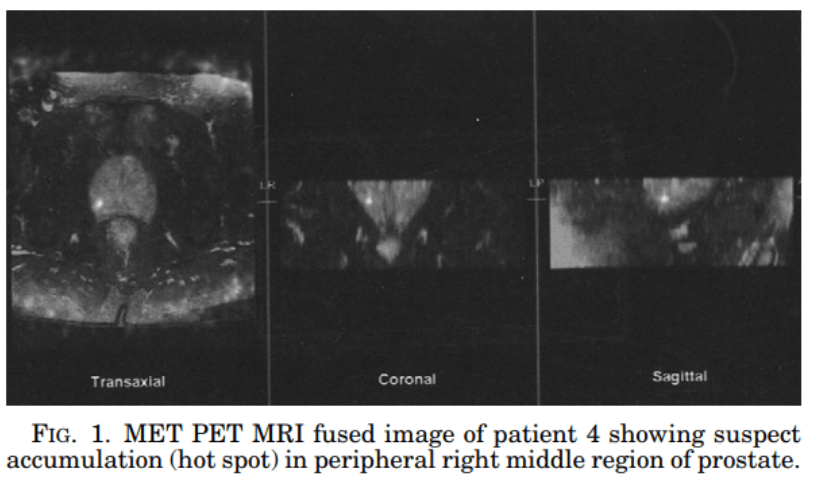
So selenomethionine really has it all:
(1) Inhibits polyamines
(2) Inhibits prostaglandin E2
(3) Is concentrated in the prostate – especially in the hyperproliferative areas
It has been estimated that Americans generally consume 80 to 165 micrograms per day of selenium, yet Clark showed 200 micrograms per day to be perfectly safe and effective.
Some studies have concluded that even 724 micrograms per day is a safe amount.
But the official RDA (55 micrograms) is naturally set lower to provide a large safety margin.
Those are expressed in terms of selenium, and 724 micrograms of selenium would equal 1,796 micrograms of selenomethionine (×196⁄79).
This is just under the amount that caused minor skin problems in macaques.
So 2,000 micrograms per day for an 80 kg (175 lb) human should probably be taken as an upper limit.
You can get selenomethionine as a supplement.
Some foods that contain selenium: Brazil nuts and walnuts, tuna, cod, beef, turkey, chicken, eggs, oatmeal, rice, cottage cheese, cheddar cheese.
—-Important Message—-
New Breakthrough: Secret to Getting Erections for 30 Minutes or Longer
I’ve made a breakthrough discovery that lets any man feel like a teenager again with incredibly high penis sensitivity…
…and fantastic, long-lasting erections, anytime, whenever he wants…
Why does it work?
My new discovery works with a unique method… This is proven with over 70 years of hard science including pioneering work from Masters & Johnson that Big Pharma wishes would disappear…
My discovery makes the penis incredibly sensitive like it used to be – you will experience the most mind-blowing exquisite sexual pleasure.
Many men think this would make them come too fast – but it does not. Not with my simple little method.

————

- Witherington, R. "Decreased incidence of prostate cancer with selenium supplementation: results of a double-blind cancer prevention trial." British journal of urology (1998)
http://onlinelibrary.wiley.com/doi/10.1046/j.1464-410x.1998.00630.x/full - Redman, C. "Involvement of polyamines in selenomethionine induced apoptosis and mitotic alterations in human tumor cells." Carcinogenesis (1997)
https://academic.oup.com/carcin/article-pdf/18/6/1195/9747846/181195.pdf - Baines, A. "The mechanism of action of the anticancer effects of selenomethionine on colon cancer." (2001)
https://repository.arizona.edu/bitstream/handle/10150/290479/azu_td_3023494_sip1_m.pdf?sequence=1 - Zamamiri-Davis, F. "Nuclear factor-κB mediates over-expression of cyclooxygenase-2 during activation of RAW 264.7 macrophages in selenium deficiency." Free Radical Biology and Medicine (2002)
http://citeseerx.ist.psu.edu/viewdoc/download?doi=10.1.1.716.8946&rep=rep1&type=pdf - Tóth, G. "Detection of prostate cancer with 11C-methionine positron emission tomography." The Journal of urology (2005)
https://www.ncbi.nlm.nih.gov/pubmed/15592030
- Selenium — Health Professional Fact Sheet
https://ods.od.nih.gov/factsheets/Selenium-HealthProfessional/ - Dietary Reference Intakes for Vitamin C, Vitamin E, Selenium, and Carotenoids (2000)
https://www.nap.edu/read/9810/chapter/9

Leave a Reply